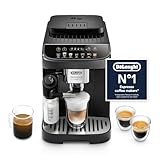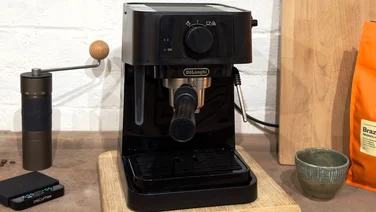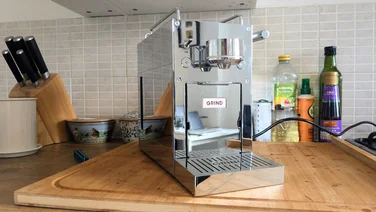To help us provide you with free impartial advice, we may earn a commission if you buy through links on our site. Learn more
- Best coffee machine: At a glance
- The best coffee machines you can buy in 2025
- 1. De'Longhi Magnifica Evo One Touch: Best value bean-to-cup machine
- 2. L'or Barista Sublime: Best Nespresso compatible machine
- 3. De’Longhi Stilosa: Best budget manual espresso machine
- 4. Melitta Aromaboy: Best budget filter coffee machine
- 5. Jura C8: Best premium bean-to-cup coffee machine
- 6. Sage Oracle Jet: Best automatic espresso machine
- 8. Ninja Luxe Café Premier: Best semi-automatic coffee machine for beginners
- 9. Gaggia Classic Pro: Best for espresso hobbyists
- 10. Sage Luxe Brewer: Best filter coffee machine
- We also tested...
- How to choose the best coffee machine for you
- Our highly-caffeinated reviewers have tested over 120 coffee machines
- We test these machines in our homes, comparing models against their closest rivals so we can judge with confidence. We maintain consistency where possible, using top-quality coffee beans, ground in the same grinder and dosed accurately.
- One of our favourite coffee machines is the De’Longhi Magnifica Evo One Touch, a fantastic value bean-to-cup machine that makes espresso, cappuccinos, lattes and more with ease.
- Alternatively, if you’re after even more convenience with a capsule machine, consider the L’or Barista Sublime: a Nespresso-compatible machine that can make two espressos at once and is regularly priced below the £100 mark.
- Read on for our roundup of the best coffee machines, from fully-automatic bean-to-cup marvels to manual espresso, pod and filter machines.

Manual espresso, bean-to-cup, pod or filter? The best coffee machines come in a variety of shapes, sizes and types – and we’ve reviewed them all. Our favourites include the De’Longhi Magnifica Evo, the L’or Barista Sublime and the Sage Oracle Jet, but the best choice for you depends on your coffee habits – and of course your budget.
We’ve reviewed over 123 coffee machines here at Expert Reviews, putting them through their paces so that we can offer recommendations and buying advice that you can trust. If you’re not quite sure which machine will suit you best, read on for our reviews roundup and buying guide. For those in a hurry, our at-a-glance list below lets you skip to the reviews you’re most interested in or quickly check prices at major retailers.
Best coffee machine: At a glance
- De’Longhi Magnifica Evo One Touch: Best value bean-to-cup machine | Check price at Amazon
- De’Longhi Stilosa: Best budget manual espresso machine | Check price at Argos
- Sage Oracle Jet: Best automatic espresso machine | Check price at Sage
- L’or Barista Sublime: Best Nespresso compatible machine | Check price at Amazon
- Sage Luxe Brewer: Best filter coffee machine | Check price at Sage
How we test coffee machines
All of the machines here have been extensively tested in our own homes, and we always compare models new and old against their closest rivals to ensure that our recommendations stand up to scrutiny. If we say one machine is better than another, it’s because we’ve tested them side by side.
For machines that use coffee beans or ground coffee, we source top-quality single-origin coffee beans from some of our favourite roasters such as Craft House Coffee, and we use a popular, affordable grinder – the Iberital MC2 (~£150) – to make reliable, repeatable comparisons between machines. For capsule machines, we select our favourite pods and capsules from the manufacturer’s own ranges.

We’re not professional baristas, but we do know how crucial it is to use great-quality coffee beans that are ground to perfection, dosed accurately with digital scales and brewed for a consistent amount of time. If a machine makes great coffee in our kitchen, you know it’s capable of doing the same in yours.
The best coffee machines you can buy in 2025
1. De’Longhi Magnifica Evo One Touch: Best value bean-to-cup machine
Price when reviewed: £549 | Check price at Amazon

Reviewed By Sasha Muller
- Affordable
- Easy to use
- Good range of drink options
- Tweaking required for best results
- No option for hot milk without coffee

Fully automatic bean-to-cup machines tend to command a hefty premium over standard models that rely on manual milk frothing, but the Magnifica Evo One Touch finally bucks the trend. This classy little machine has a suggested retail price of around £549, which is still cheaper than many fully auto rivals, but the good news is that we’ve regularly seen it on sale for around £420. At full price, it’s a steal; at a discount, it’s a bona fide bargain.
It’s not just affordable, either. We found the delightfully simple controls made it much easier to use than previous models, and in testing, it poured tasty drinks with zero hassle. Simply top up the 250g hopper with the best beans you can find, fill the water tank, add milk to the carafe and the One Touch pours lattes, cappuccinos, latte macchiatos, espressos and long blacks with a single press of a button.
Read our full De’Longhi Magnifica Evo One Touch review
Key specs – Dimensions (WDH): 440 x 360 x 240mm; Water capacity: 1.8l; Cup warmer: Yes; Milk frothing: Yes (automatic); Adjustable grind: Yes; Adjustable strength: Yes
2. L’or Barista Sublime: Best Nespresso compatible machine
Price when reviewed: £110 | Check price at Amazon

Reviewed by Danielle Amato
- Variety of capsules available
- Compact
- Dual-spout can make two espressos at once
- Not compatible with Vertuo pods
- Fingerprint-prone

That’s right: the best-value Nespresso machine isn’t even made by Nespresso. The Barista Sublime is made by Philips, branded by L’or and it’s a Nespresso-compatible machine that also accepts L’or’s own standard and XXL capsules. We think it looks great and it regularly dips well below the £100 mark, all the while serving up cracking coffee.
It’s not compatible with Nespresso’s newer, larger Vertuo capsules, but that’s no great shakes – with both Nepresso’s standard capsule ranges you still have a huge amount of different blends and varieties to choose from. In testing, we found it both incredibly easy to use and easy to clean. There’s also a generous pod bin and we found it fit perfectly in our small office space. The clincher? L’OR’s own XXL capsules make it possible to serve up two 32ml espressos at the same time – or just pour yourself one super-tasty 270ml lungo. Brilliant.
Read our full L’or Barista Sublime review
Key specs – Dimensions (WDH): 157 x 402 x 276mm; Water capacity: 0.8l; Cup warmer: No; Milk frothing: No; Heat-up time: 7secs; Coffee sizes: Ristretto, Espresso, Lungo (up to 270ml); Maximum cup size: 120mm; Used capsule capacity: Up to 9 capsules
3. De’Longhi Stilosa: Best budget manual espresso machine
Price when reviewed: £90 | Check price at Argos

Reviewed by Sasha Muller
- Cheap as chips
- Good espresso results
- Easy to use
- Plasticky
A competent manual espresso machine for less than 100? You betcha. There are a few Stilosa models to be aware of, but the one we recommend is the EC230.
You’re getting a lot for your money here: a 1l water tank, unpressurised baskets for single and double shots, and a proper metal steam wand for smooth and silky foams. Results are strikingly impressive for such an affordable machine, and we produced some great espressos during our testing. I should add that you’ll probably want to pair it with a decent coffee grinder, but if you’re spending just double figures on your coffee machine, you should have space in your budget.
It’s also a doddle to use, with a single dial on the front to switch between espresso, steam and hot water. The build is quite plasticky but that’s entirely forgivable at this price, and we actually think it looks rather nice on the whole.
Read our full De’Longhi Stilosa review
Key specs – Dimensions (WDH): 255 x 290 x 315mm; Water capacity: 1l; Cup warmer: Yes; Milk frothing: Manual (steamer wand); Coffee type: Ground (espresso)
4. Melitta Aromaboy: Best budget filter coffee machine
Price when reviewed: £45 | Check price at Melitta

Reviewed by Gareth Thomas
- Gorgeous
- Easy to use
- Affordable
- Small capacity isn’t suitable for larger households
- Niche filter papers
Just as cute as its name suggests, the Aromaboy is a charming little filter coffee machine. I, for one, love the retro brown and beige colourway, chunky rocker button and dinky glass carafe.
It’s not just a pretty face either, results are good too. After a bit of experimenting with dosages and grind size (I found the sweet spot somewhere between fine and medium fine), I was able to make a very decent cup of coffee with the Aromaboy, and – on the rare occasion that I didn’t drink it all straight away – the hot plate kept it nice and warm for up to 40 minutes.
You’re inevitably limited by the size of the Aromaboy, and I found the Melitta’s Size 100 filter papers aren’t as widely available as its larger alternatives. But its as small in price as it is in stature: At full price, the Aromaboy will cost you £45, but you can often find it discounted to around £30 during deals events such as Black Friday.
If you’re short on kitchen space and you’re only making coffee for yourself, it’s a beautiful – not to mention affordable – choice.
Read our full Melitta Aromaboy review
Key specs – Dimensions (WDH): 169 x 128 x 198mm; Water capacity: 0.31l; Machine type: Filter; Stay warm: Yes (hot plate); Coffee type: Ground (filter); Warranty: 2 years
5. Jura C8: Best premium bean-to-cup coffee machine
Price when reviewed: £895 | Check price at John Lewis

Reviewed by Sasha Muller
- Makes great coffee
- Easy to use
- Great milk frothing system
- Expensive
- Only four drink options
The Jura C8 is a straightforward, well-designed and attractive bean-to-cup coffee machine. It’s easy to use and we were particularly impressed with its milk frothing system. You can use the rubber tube with the glass carafe that comes included with the machine, as well as your own jug or milk bottle, and it’s easy to maintain, with replacement tubes costing just a few pounds.
The drink selection is quite barebones: you’re limited to espresso, cappuccino, americano and latte macchiato. But what it lacks in variety it certainly makes up for in quality. The C8 makes fantastic coffee, and our tester noted more body in the shots produced when compared to the De’Longhi Magnifica Evo One Touch featured above.
Of course, you’re paying a lot of money for that body: £895 is quite a lot of money for what Jura considers “premium economy”. If your budget can’t stretch, you’ve got the De’Longhi Magnifica Evo One Touch. But if you do have the cash to spend, this is an excellent bean-to-cup coffee machine.
Read our full Jura C8 review
Key specs – Dimensions (WDH): 260 x 437 x 325mm; Water capacity: 1.6l; Bean hopper capacity: 200g; Cup warmer: No; Milk frothing: Automatic (steamer wand); Coffee type: Ground (espresso)
6. Sage Oracle Jet: Best automatic espresso machine
Price when reviewed: £1,700 | Check price Sage

Reviewed by Danielle Amato
- Near faultless performance
- Impressive milk steaming with good dairy alternative options
- Expensive
- Pucks can be tricky to remove from the portafilter basket
Sage’s Oracle Jet is the definition of you get what you pay for. While expensive, it’s unlikely that you’ll find a better automatic espresso machine that delivers both a near perfect user experience and really good espresso. From shot calibration and precision grinding, to cold brew and customisable milk steaming for both dairy and plant alternatives, this machine does it all.
In my tests, I struggled to find any faults with day to day performance. Dosing, tamping and shots were all super accurate and as my beans aged, the Oracle Jet took note and suggested adjusting my grind size. I was also really impressed with the taste of the ‘cold brew’ coffee it produced, which is as close as you’ll get to the real deal without spending 24+ hours on it. I think the level of milk customisation is also really worth shouting about here. The Jet has four individual settings for dairy, oat, almond and soy milk, allowing you to get the very best from each one with temperature adjustments.
Most importantly, in terms of basic espresso quality, the Jet is very good. Is it quite similar to the Barista Touch? Yes, though there are lots of additions to this machine that I think are worth the extra few hundred pounds you’ll have to spend including an hugely improved touch screen and automatic firmware updates to improve the longevity of the machine.
Read our full Sage Oracle Jet review
Key specs – Dimensions (WDH): 35 x 38 x 42cm; Water capacity: 2.3l; Bean hopper capacity: 340g; Cup warmer: Yes; Milk frothing: Manual and automatic (steamer wand); Coffee type: Beans
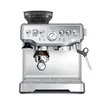
ALSO CONSIDER: Sage Barista Express (£630)
If you can't quite stretch to the Oracle Jet but want a manual espresso machine with a built-in grinder, the Barista Express is a great value pick – it looks great and makes very decent coffee indeed.
7. Nespresso Vertuo Pop: Best budget Nespresso machine
Price when reviewed: £96 | Check price at Amazon

Reviewed by Danielle Amato
- Compact with fun colour choices
- Tasty drink options
- Struggles with taller mugs

The Nespresso Vertuo pop is the latest addition to the Vertuo range and is supremely easy to use with its simple, single-button control scheme. It works with Nespresso’s larger Vertuo capsules to brew four coffee sizes – espresso (40ml), double espresso (80ml), lungo (120ml) and mug (230ml). Alongside its variety of pods, the Pop comes in a large range of eye-catching colours including spicy red, pacific blue, aqua mint and mango yellow to name a few.
This model is quite a bit smaller than its predecessors and as such, we noticed that some of the original assets have been tweaked. The water tank has been reduced to 600ml, while the capsule bin fits a maximum of eight used pods. Nespresso has also reduced the space underneath the brew head, meaning the tallest mug you’ll be able to fit below is 8cm, or 12cm if you remove the drip tray. In testing, we found that a few of our taller mugs simply wouldn’t fit under the brew head, but most standard mugs will still fit without issue. If space is your main concern and you’re happy to look past these minor grumbles, the Pop is a sleek and simple coffee machine providing excellent value for money.
Read our full Nespresso Vertuo Pop review
Key specs – Dimensions (WDH): 426 x 250 x 136mm; Weight: 3.5kg: Heat up time: 30secs; Coffee sizes: Espresso, double espresso, gran lungo, mug; Maximum cup size: 80mm, 120mm (without drip tray); Water capacity: 600ml; Used capsule capacity: 8
8. Ninja Luxe Café Premier: Best semi-automatic coffee machine for beginners
Price when reviewed: £550 | Check price at Ninja

Reviewed by Danielle Amato
- Good value for money
- Easy to use
- Filter coffee could be better
- Not the best choice for user control
The Ninja Luxe Café Premier is the perfect option for anyone looking to buy their first coffee machine without spending over £1,000 or becoming a fully-fledged barista.
This versatile semi-automatic coffee machine includes basket accessories for making single, double and quadruple espressos, and can also produce filter coffee, cold brew and frothed dairy and plant milk. I say semi-automatic, but with the Luxe Premier’s “Barista Assist” system, the machine will recommend a grind size, weigh out your coffee with a digital scale built into the grinder and can calibrate things like brew time and temperature based on how well your espresso shot pulls, leaving very little up to the user.
As well as being super easy to use and producing reliably solid coffee, the Luxe Premier is also well-built and surprisingly compact. It’s also a lot cheaper than many of its semi-automatic rivals, making it a great option for anyone looking to pick up a hassle-free espresso machine for less.
Read our full Ninja Luxe Café Premier review
Key specs – Dimensions (WDH): 336 x 344 x 372mm; Water capacity: 2l; Bean hopper capacity: 350g; Cup warmer: Yes; Milk frothing: Automatic/Manual; Coffee type: Beans
9. Gaggia Classic Pro: Best for espresso hobbyists
Price when reviewed: £489 | Check price at Coffee Friend

Reviewed by Sasha Muller
- Ideal for tinkering perfectionists
- Great espresso
- Minimalist design
- Build quality could be more refined

The Gaggia Classic Pro is the undisputed champion in the sub-£500 category. It’s a plain, no-frills manual espresso machine that proved itself capable of serving up superb espresso time and time again in our repeat tests. There are no fancy extras, and no automation of any kind, but we would still argue that this is a machine that’s built to last – and it looks great, too.
The Classic Pro lacks the integrated burr grinder of some rival machines – and bear in mind that a basic grinder will cost at least £50 or more – but it makes vastly better coffee. We found it can take a little effort to get the very best out of the Classic, but it’s unbeatable for the money and capable of serving up the kind of coffee that rivals pricier machines.
Read our full Gaggia Classic review
Key specs – Dimensions (WDH): 230 x 240 x 380mm; Water capacity: 2.1l; Cup warmer: Yes; Milk frothing: Manual (steam wand); Coffee type: Ground
10. Sage Luxe Brewer: Best filter coffee machine
Price when reviewed: £250 | Check price at Sage
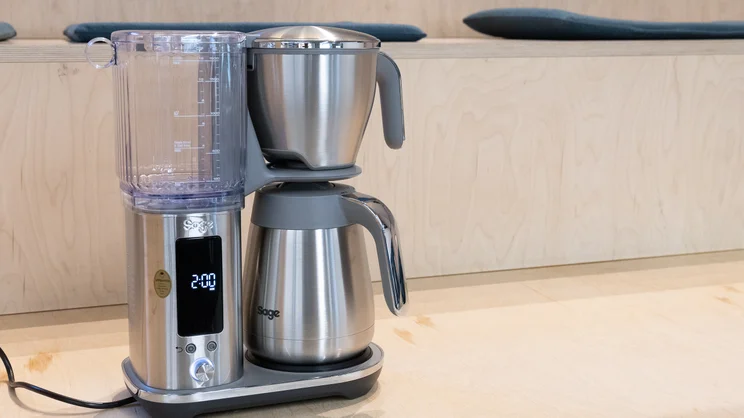
Reviewed by Gareth Thomas
- Great features
- Choice of filter baskets
- Large capacity
- Can be tricky to get the hang of at first
The Sage Luxe Brewer is the most thoughtfully designed filter coffee machine I’ve reviewed. Its one-touch “Brew” setting has been adjusted to meet the standards of the Specialty Coffee Association (SCA), but you can also fine-tune variables including water temperature, bloom time and flow rate.
Not only that, but the machine comes with a water filter, a choice of three filter baskets and a testing strip to measure the hardness of your water so you can adjust the machine’s settings accordingly. All this considered, it’s hardly surprising that the Luxe Brewer makes excellent coffee. During my testing, I was brewing tasty, well-balanced filter brews – that is, once I got to grips with how the machine works (the included paper manual is notably unhelpful).
It’s got a spacious 1.8l water tank and comes with a large insulated carafe, so it’s great for whole families of coffee drinkers. If you care about your filter coffee, it’s a fantastic choice.
Read our full Sage Luxe Brewer review
Key specs – Dimensions (WDH): 372 x 177 x 408mm; Water capacity: 1.81l; Machine type: Filter; Stay warm: Yes (insulated carafe); Coffee type: Ground; Warranty: 2 years
11. Clever Dripper: Best immersion brewer
Price when reviewed: £23 | Check price at Ozone Coffee

Reviewed by Gareth Thomas
- “Pour over” made easy
- Well-balanced filter coffee
- Tricky to clean
- Not great for making massive amounts of coffee
If you’ve always wanted to get into pour over coffee but have been intimidated by how tricky it is to get a consistent cup of coffee with the V60, then there’s nothing I can recommend more than the Clever Dripper.
It’s very simple to use: put your filter paper and chosen ground coffee before pouring over water and letting the coffee steep. Unlike the V60 and Chemex brewers, the cover won’t drip through immediately. This is thanks to a pressure plate underneath the dripper that opens up a channel when depressed, i.e. whenever you place the dripper on top of your mug or carafe. In our tests, the resulting brewed coffee had a nuanced taste and clarity that you might not always expect from an immersion brewer.
There are, of course, a couple of downsides. It can be a bit tricky to clean it properly, especially on the underside where the pressure plate is. You’ll also need to factor in the cost of the single-use filter papers required to brew coffee with the dripper. This aside, I’ve been using the Clever Dripper for almost four years now and have found it to be one of the most consistently impressive and easy-to-use coffee makers I own.
Read our full Clever Coffee Dripper review
Key specs – Dimensions (WDH): 127 x 152 x 152mm; Water capacity: 300/500ml; Machine type: Filter; Stay warm: No; Warranty: N/A
We also tested…

As I said above, we’ve reviewed over 123 coffee machines here at Expert Reviews. And while some of our favourites can be found in our roundup above, it’s not an exhaustive list. We won’t waste space listing the rest here, but here are some of the other machines we’ve reviewed recently:
- Sage Oracle Dual Boiler
Our rating: 4/5 | Price when reviewed: £2,500 | Check price at Sage - Melitta EPOS
Our rating: 3/5 | Price when reviewed: £350 | Check price at Melitta - Fellow Aiden
Our rating: 4/5 (Recommended) | Price when reviewed: £299 | Check price at Amazon - Melitta AromaFresh Therm Pro
Our rating: 4/5 (Recommended) | Price when reviewed: £290 | Check price at Melitta - Sage Barista Touch Impress
Our rating: 4/5 (Recommended) | Price when reviewed: £1,200 | Check price at Sage - Grind Two Coffee Pod Machine
Our rating: 4/5 | Price when reviewed: £295 | Check price at Grind - ProCook Coffee Pod Machine
Our rating: 4/5 | Price when reviewed: £149 | Check price at ProCook - De’Longhi Rivelia
Our rating: 4/5 | Price when reviewed: £795 | Check price at Amazon - Nespresso Vertuo Creatista
Our rating: 4/5 | Price when reviewed: £649 | Check price at John Lewis - Lavazza Jolie Evo
Our rating: 4/5 (Recommended) | Price when reviewed: £99 | Check price at Amazon
How to choose the best coffee machine for you
Should you buy a manual espresso machine?
Pros: Best-tasting coffee; flexibility | Cons: Fiddly; can be messy

If you want the flexibility to create anything from espresso to ristretto to cappuccino, a manual espresso machine similar to what you find in coffee shops is the best choice. The downside is that you’ll need to learn to manually grind and tamp the coffee, steam your own milk to perfection, clean the machine and repeat the process for every cup, but the added control makes it possible to get the absolute best from every variety of coffee.
Should you buy a bean-to-cup machine?
Pros: Easy to use; good coffee | Cons: Expensive; awkward to clean

If manual espresso sounds like too much work then a bean-to-cup machine is a great choice. Simply pop water and coffee beans in the machine, and you can get a shot of coffee at the press of a button – and without cleaning the machine between every single shot. Pricier machines include integrated milk frothers that dispense a cappuccino or white coffee at the press of a button. The results are never as good as manual machines though, and prices start at around £400.
Should you buy a coffee pod or capsule machine?
Pros: Quick, consistent results; mess-free | Cons: Inferior taste to manual espresso

This is the simplest option of all – and basic machines start around £50. Each pod or capsule contains the perfect amount of coffee, so you simply buy the type with the strength and flavour you like best. For no-hassle, no-mess coffee that tastes consistently good, they’re hard to beat. Some machines add built-in milk frothing so you can get a latte or cappuccino at the touch of a button. The results don’t taste as good as manual espresso or bean-to-cup machines, though, and pods can be pricey.
Should you buy a filter coffee machine?
Pros: Easy to use; makes big jugs of coffee | Cons: Only makes black coffee

If you just want plain and simple coffee to fill a mug, or want to be able to make enough coffee for several people at once, a filter coffee machine is a great choice. These generally require you to use ground coffee (although a few do have integrated grinders), but they’re a good bet for making simple, tasty black coffee.
How often should I clean my coffee machine?
Coffee machines require maintenance to keep them working (and looking) their best. This means descaling it on a semi-regular basis. How often you do this will depend on the hardness of your water and how often you use your machine, but a good general rule is to descale every few months. Brands will usually provide their own guidance too: Nespresso, for instance, recommends descaling every six to 12 months, while De’Longhi is a bit more specific in their recommendation to descale your espresso machine after 200 uses.
Descaling aside, you should take care of the different parts of your coffee machine on a much more regular basis. This includes emptying and cleaning the drip tray, wiping out the portafilter and purging the steam wand. If you have a filter coffee machine, you should wash the jug and filter frequently. I wash my Melitta Aromaboy jug and rinse out the filter cone daily.
How much should I spend on a coffee machine?
This is a tricky question to answer simply. For a start, it depends on the type of coffee machine you’re after. For instance, a filter coffee machine will usually be a good bit cheaper than a high-spec bean-to-cup machine: though they’re designed to do completely different things, the Sage Luxe Brewer (£250) is a cheaper option than the De’Longhi Magnifica Evo One Touch (£550).
Many people will tell you that you should pay as much as you can for your coffee machine, and this is true to a point. You get what you pay for, and there are plenty of false economies in the coffee machine market.
Ultimately, my advice would be to spend according to your budget, coffee-drinking habits and – importantly – space. While premium machines might be a worthwhile investment for some, you shouldn’t break the bank if you don’t think you’ll get your money’s worth. For instance, unless you want to really hone your barista skills and learn how to make coffee shop-quality flat whites, there’s not much point sinking £500 on the Gaggia Classic. And if you’re usually happy getting cheap coffee beans from the supermarket every month, spending two-and-a-half grand on something like the Sage Oracle Dual Boiler is probably overkill. If you want a basic manual machine, you might be just as happy getting a good sub-£100 deal on the De’Longhi Stilosa. And if you just want a quick espresso fix in the morning, a cheaper pod machine might be the best choice for you. Our roundup above is tailored to cater for all needs and budgets.
